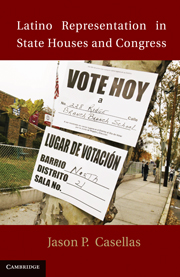Book contents
- Frontmatter
- Contents
- List of Tables
- List of Figures
- Acknowledgments
- Introduction
- 1 Latinos in Legislatures
- 2 The Effects of Population, Turnover, and Term Limits on Latino Representation
- 3 District Composition and the Election of Latino Candidates
- 4 Electing Latinos in Non-Latino Majority Districts
- 5 Voices from Within
- 6 Roll Call Voting Behavior of Latino Legislators
- 7 Conclusion
- Appendix A
- Appendix B
- Appendix C
- Appendix D
- Appendix E
- References
- Index
4 - Electing Latinos in Non-Latino Majority Districts
Published online by Cambridge University Press: 10 January 2011
- Frontmatter
- Contents
- List of Tables
- List of Figures
- Acknowledgments
- Introduction
- 1 Latinos in Legislatures
- 2 The Effects of Population, Turnover, and Term Limits on Latino Representation
- 3 District Composition and the Election of Latino Candidates
- 4 Electing Latinos in Non-Latino Majority Districts
- 5 Voices from Within
- 6 Roll Call Voting Behavior of Latino Legislators
- 7 Conclusion
- Appendix A
- Appendix B
- Appendix C
- Appendix D
- Appendix E
- References
- Index
Summary
“But we are different from Latinos in places like Texas, Florida, and California because we are extremely new to the state. We do not have an established Latino middle class.”
– Sen. Jarrett Barrios (D-Boston)What accounts for the election of Latinos to districts in which Latinos are not a majority? Are Latinos elected primarily in majority-African-American districts or majority-white districts? Are Latinos winning by appealing to the Latino pluralities in their districts and then adding the minimum number of non-Latino voters? Are Latinos defeating incumbents? If so, are they white or African-American incumbents? Are they winning in multicandidate primaries? Do Latinos with Anglo names appear to have an advantage? To what extent has each political party been responsible for the growing number of Latinos elected in non-Latino majority districts? To what extent have features of the electoral system contributed to more Latino victories in such districts? Now that Latinos have become the largest minority group in the United States, it is fitting to examine the conditions under which Latinos are elected to legislative bodies. In particular, this chapter seeks to explore the conditions under which Latinos are elected to non-Latino majority districts. I argue that although demographics play an important role in the election of Latino candidates, we must look beyond the obvious Latino majority districts that elect Latino legislators. The growing mainstreaming of Latinos in American society is already manifesting itself in the election of Latino legislators in areas where traditionally they are not likely to be elected.
- Type
- Chapter
- Information
- Latino Representation in State Houses and Congress , pp. 76 - 105Publisher: Cambridge University PressPrint publication year: 2010



